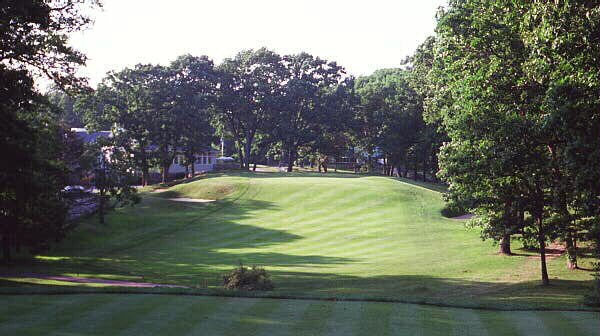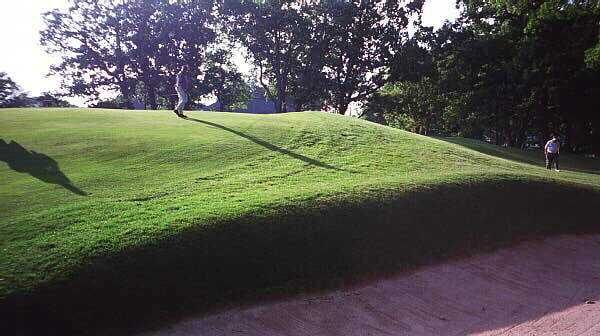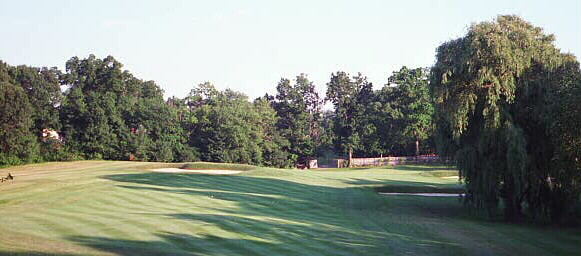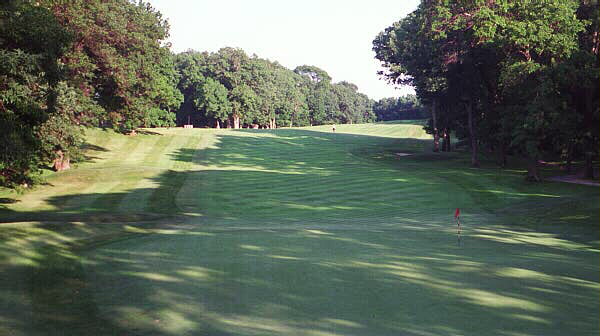Charles River Country Club
MA, USA

Ross used the tumbling New England topography, as seen here from behind the 12th green, to create a number of distinctive and unique holes at Charles River.
Every architect talks about letting the land dictate the placement of the holes and getting the most fromthe site. Ironically, these same architects then ruthlessly stamp outone golf course after another with balanced sides, each having two par threes and two par fives with the rest par fours. How can that be? If architects were genuinely following nature’s lead, there would be more oddities such as the back to back set of one and three shotters at Cypress Point or the back nine at Pacific Dunes where only two two shot holes are found.
Donald Ross is another architect who let the best holes fall where they may and his design at Charles River is a sterling example. From the one shot 9th to the one shot 17th hole, there are just two two shot holes (and both of these are under 365 yards) with the rest of comprised of three three shotters and two more one shotters.
This unconventional string of ‘pars’ works beautifully at Charles River because each hole perfectly employs the dominant natural features and thus each one is both natural and distinctive. Not one hole in this stretch reminds the golfer of any other Ross hole.
Though set across rugged terrain, Charles River exemplifies why a Ross course is such a delight to play. Ross never forces the golfer to hit a particular shotbut instead his designs are accepting of diverse styles of play. One result is that a Ross course can confuse the better player into considering too options.
Take the 515 yard 2nd hole as an example. Considered by many as the most innocuous hole on the course as it falls across the only relatively flat section of the property, the 2nd is clear sailing off the tee and the green is open in front as well. The weaker player can bumble his ball along the ground and still entertain good hopes of making par.The tiger is thinking of forcing the issue to ensure a birdie. And yet, below fairway level on both the right and left sides of the fairway leading up to the green are a series of deep bunkers. The overanxious swing by the tiger is likely to send a ball into one of these bunkers and from there the player is grateful to get down in three shots. So, while the hole is a delight for all golfers, the better player must continually review his best options. Should I really go for the green? Am I better served to lay back and hit the resulting straightforward pitch close? There is no clear answer and such indecision often proves the undoing of a good player at Charles River where he never quite scores as well as he thinks he should.
The term ‘member’s course’ can have negative connotations to some (remember the furor created when Jack Nicklaus called Royal Melbourne ‘a fine member’s course’?) so one must be specfic in the term’s use. To say Charles River is an ideal member’s course is meant to imply that is the perfect balance of fun and challenge to where one would enjoy playing it several times a week forever. It is not meant to imply that Charles River is accepting of sloppy golf. Indeed, when Charles River hosted the 36 hole stroke play portion of the 1972 U.S. Amatuer with each player playing one round at The Country Club (Brookline) and one at Charles River to determine the match play field,. the medal scores were higher at Charles River than at The Country Club!
The classic Ross give-and-take is one of the design’s greatest attributes: the tough 1st followed by the reachable par five 2nd, the nearly drivable 3rd shortly followed by the number one handicap hole, the reachable 7th and 10th sandwich the tough 8th and 9th and so it goes on the back side as well.The 240 yard 11th requires a driver for many and the 14th is a long iron over a deep valley but in between, there are two short two shotters.

Charles River has at least a half-dozen half par holes (3, 7, 10, 11, 15, and 18). With such features as a cross bunker (as seen above) and a fallaway green, the expected birdie on this 470 yard 7th hole often times fails to materalize for the tiger golfer.
Unlike many modern courses that beat up the golfer if he is off his game on the day, Charles River remains fun to play even when your ‘A’ game is at home. Isn’t Ross the all-time master at designing such courses?
Holes to Note
First hole, 420 yards; Similar to the 1st at Salem Country Club, this opener features a lovely view from its elevated tee across the rolling New England landscape to the green on a far hillock. As visually appealing as the hole is, the real showstopper is the immense 8,000 square foot green that easily has a dozen excellent hole locations. Also, given that many golfers won’t find the green in regulation, it serves as the first of many interesting recovery options that the golfer will face during his round.
Fifth hole, 400 yards; The green as opposed to its distance is why this uphiller is the number one handicap hole on the course. Located on the highest point of this portion of the property with little around it to provide perspective, the first time golfer may not appreciate just how severe the back to front and right to left pitch of the green truly is but with a four foot drop from back to front, the green can be nightmarish at today’s green speeds. However, such pitch has its own limitations and this green has only four hole locations, which is the fewest of any green on the course. Still, when coupled withother greens such as the all-world 10th with its bold interior contours, the greens at Charles River present a diverse set of challenges.

The grassed over rock formations on the left and right hand sides of the 5th fairway indicate just how rocky this site was when Ross got here in 1922.

As seen from behind the 5th, the green’s pitch has terrorized golfers for decades, and no more so than now with today’s faster green speeds.
Sixth hole, 355 yards; Ross was a dues paying member for many years at Charles River and a hole like the 6th must have given him great pleasure to watch. It is a textbook mis-direction play with the sight of the flag luring the player into aiming too far to the right on this dogleg right hole, and that’s exactly where Ross placed a string of bunkers.

No reason to flirt with these bunkers down the right hand side of the 6th fairway. The flag is visible in the distance.

Ross created a beautiful pocket in which to place the 6th green. The eight foot high grass faced bunker on the right is especially impressive.
Eighth hole, 410 yards; Highlighted in Golf has Never Failed Me and rightfully so, this is the favorite hole for many. As is evidenced in the photograph in the book, little has changed in the past 80 years, save for the growth of the trees.

The view from the 8th tee with a grassed over rock mound pinching in the fairway at the 270 yard mark, as further seen below.

The uphill approach needs to carry well onto the green’s surface; otherwise it will roll down the hill a good 8-10 paces back toward the golfer.
Charles River Country Club
MA, USA
Ninth hole, 180 yards; By locating the green on top of a rocky knob, Ross turned this one shotter into a true ‘hit it or else’ situation. The steep slopes that lead up to the green will readily kick the golfer’s ball 20 yards away and once the golfer has seen that happen, the 6,400 square foot green tends to shrink as a target.

The 9th requires a confident swing with a mid iron.

Short and right of the 9th green, this bunker is one that Prichard uncovered and restored. Suffice to say, an up and down is unlikely and a weak bunker shot is likely to see the ball return to the golfer’s feet.
Eleventh hole, 240 yards; This is where the routing would have easily broken down with a lesser architect. Holes 12-18 center around specific topographical features but that left Ross needing to place two holes over 770 yards of ground. Hemmed in by a road on the far side, what was Ross to do? He gave the 475 yard 10th great character by creating one of his boldest greens ever and in the case of the 11th, he found a dell-like area just beyond the crest of a hill and before the road and used it to create a fascinating green site for a long one shotter.The player never tires of trying to gauge how to bounce his tee ball onto the green. Indeed, Francis Ouimet once famously remarked that the hardest approach shot at Charles River was the second on the 11th! This hole deserves to be more famous but alas, two large willows at the 200 yard mark obscure the right hand side of the green and detract from its otherwise heroic proportions.

The proper line is just right of the bunker at the crest of the hill and …

…by avoiding the bunker, the tee ball will bound right and onto the 11th green.
Twelfth hole, 360 yards; The first of only three two shotters on the back nine, the drive is blind over a crest and the golfer is left with a short iron from a finicky sidehill stance with the ball below his feet ala the 8th at Pine Valley. Such a stance often creates a bit of a pull as the golfer comes over the top of his shot and inadvertently, sends his approach deep into the green. From there, it’s an easy three putt on this steeply pitched back to front green.

Before Prichard’s restoration work, these greenside bunkers featured uncharacteristically flashed up sand faces.
Thirteenth hole, 350 yards; For no good reason, some people struggle to remember specific holes on many Ross courses. Even at Pinehurst No. 2, the holes seem to run together in their mind. This is not the case at Charles River which is blessed with many instantly recallable holes and none more so than the 13th where a twisting fairway ends abruptly and the green is placed on top of a rock ledge that is some forty feet above the level of the fairway. This sharply uphill pitch is a perfect foil to the downhill, sidehill one on the last hole.

The ideal play off the 13th tee is a hard hook off the lone tree on the hillside.
Eighteenth hole, 445 yards; Perhaps the finest finishing hole in New England, this big two shotter gracefully sweeps to the left. As befits the longest two shotter on the course, the green is an extension of the fairway so the weaker club golfer never feels out of the hole. However, from 10 to 40 yards off the green, there are bunkers left and right of the fairway so the golfer needs to keep his misses straight.

The view from behind the dogleg left 18th hole.
In the early 1990s, Charles River didn’t enjoy many of the playing attributes described above. Three hundred additional trees encroached directly into Ross’s intended lines of play and smothered much of the course’s width, which is always needed on a course with severe topographical features if the average golfer is to enjoy himself. In addition, the green pads had shrunk by as much as 30% since their original inception, the bunkering with its flashed up sandyfaces had long since lost the Donald Ross grass faces, and the course in general was not presented in a fast nor firm manner.
However, thanks to the unwavering vision of knowledgeable board members who appreciated what lay underneath the surface, events started to turn for the better in 1994 when informational club meetings were held. The club board hired Ron Prichard in 1995 to create a Master Plan, which was accepted shortly thereafter. Trees were systematically removed, many of the green pads restored to their original size, the 18 tees were reconstructed and all the grass faced bunkers were faithfully restored as per old photographs. Indeed, in 1997 upon seeing the success of thisrestoration, other New England Ross clubs followed suit with Master Plans of their own.
The Club continues to showcase the course’s ultimate trump card within the Ross family of courses, which is its diverseNew England topography. As more trees are selectively felled, greater vistas across this striking property are opened up. Step by step, additional greens are being restored to their original size. Hopefully, one day both the 9th and 18th greens will come out several feet and the ‘squared off’ fronts will be restored, making their false fronts even more diabolical.
Charles River joins other Ross heavyweight courses such as Essex County and Salem CC in making the case that Donald Ross’s most compelling, distinctive work is found within a one hour’s drive of Boston and not in North Carolina.

Just imagine a game at Charles River in the autumn!
The End





![The Park, West Palm (Lit 9) [2023]](https://golfclubatlas.com/wp-content/uploads/2024/12/IMG_7092-2-scaled-500x383.jpg)


